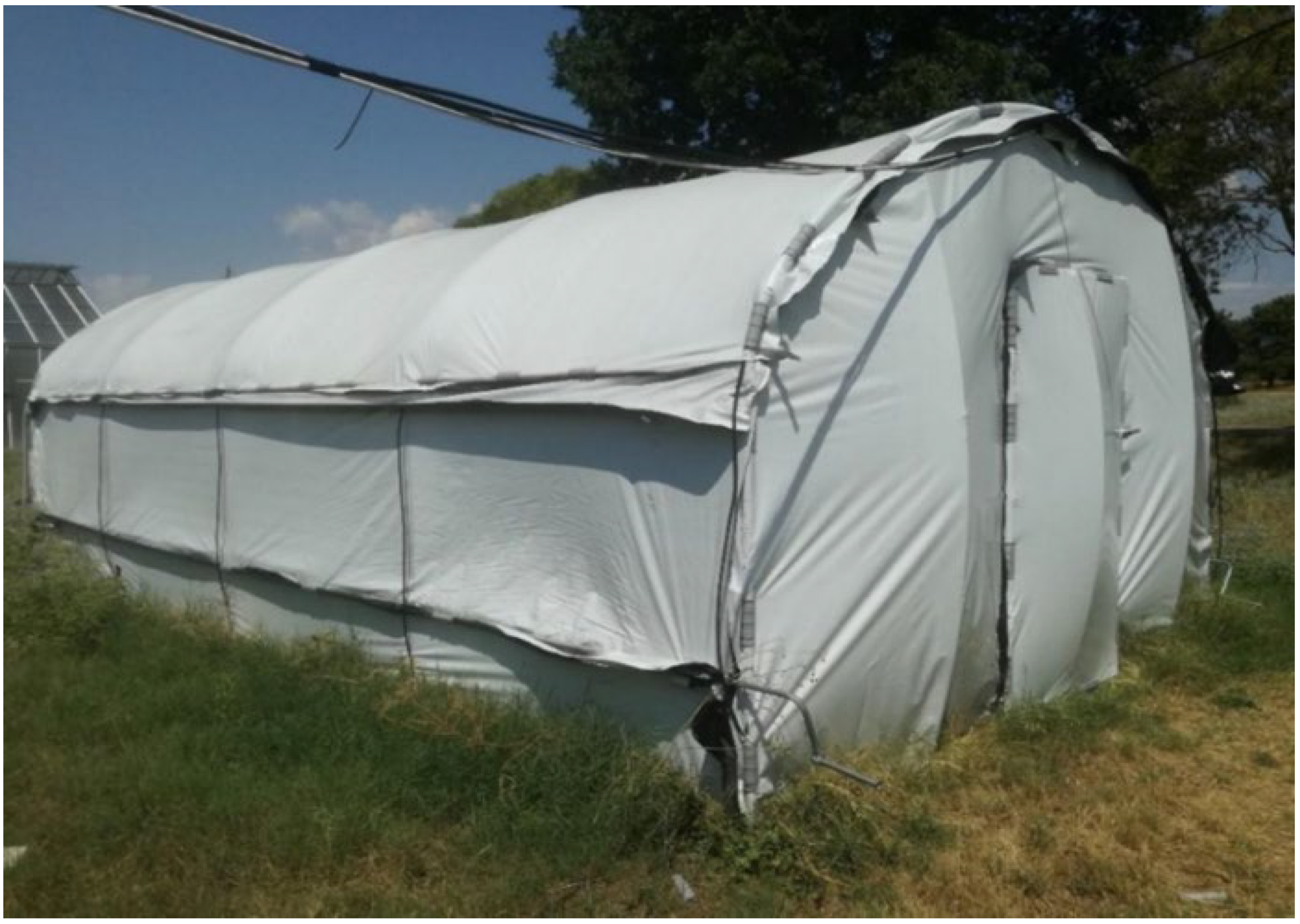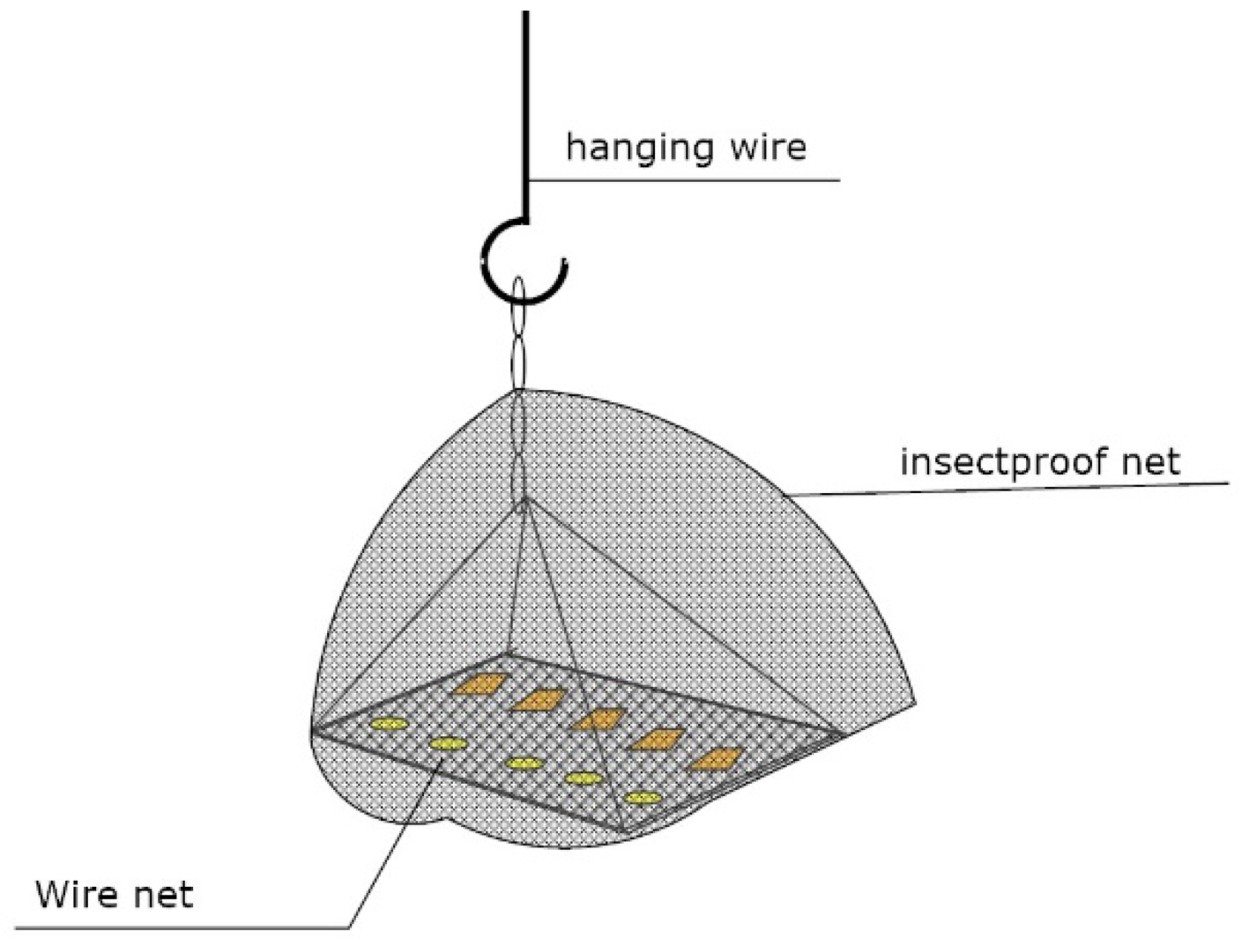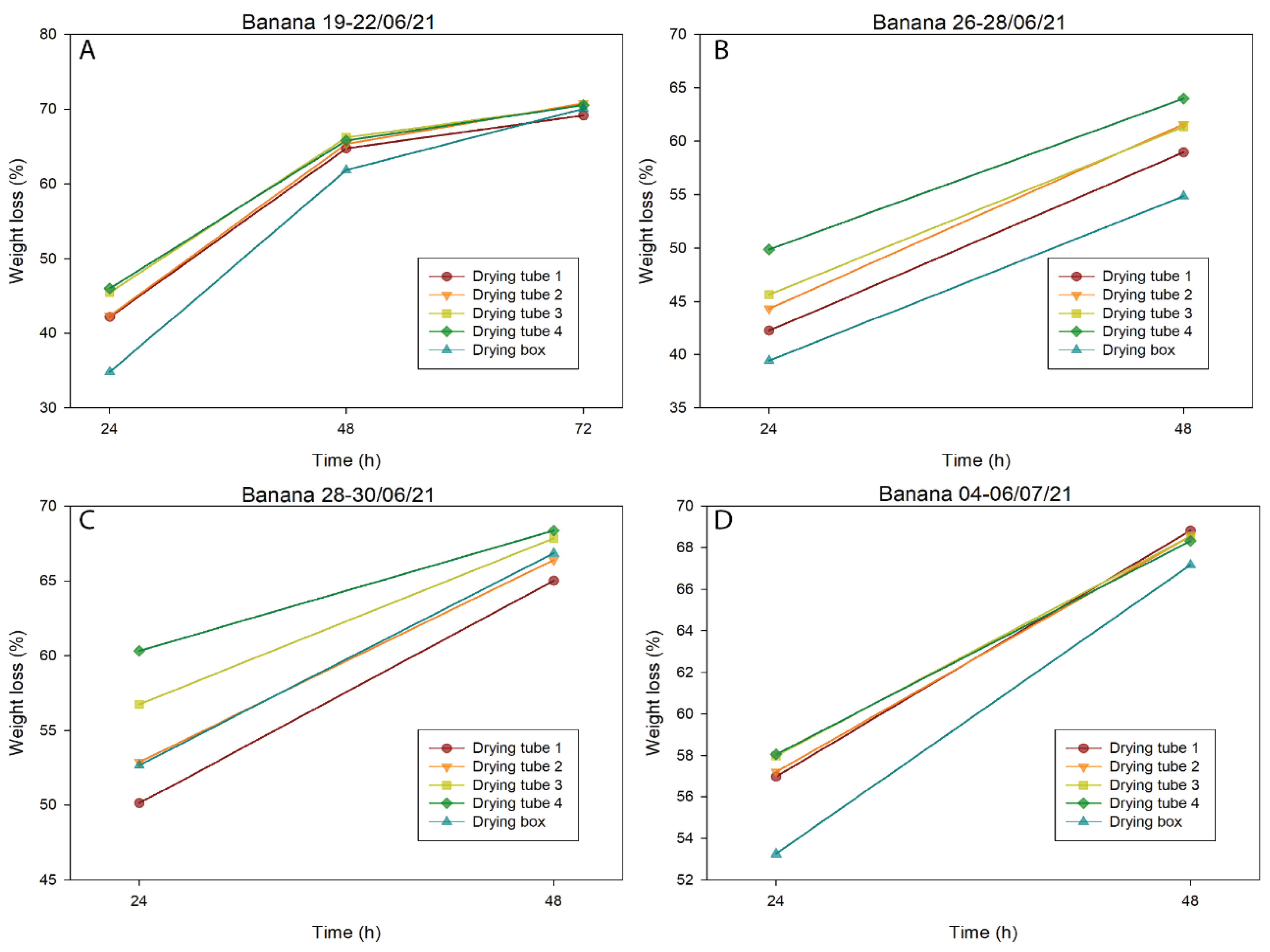A Prototype Passive Solar Drying System: Exploitation of the Solar Chimney Effect for the Drying of Potato and Banana
Abstract
:1. Introduction
- The proposed passive solar drying process, which succeeds in drying without the use of forced ventilation;
- The operation of a drying system as an indirect solar system in an already installed greenhouse structure is potentially used for different applications (non-horticulture);
- The drying tubes arrangement as an additional part of any greenhouse-type structure;
- The modification of simple tubes to efficient drying tubes for drying agricultural products.
2. Materials and Methods
2.1. Experimental Greenhouse
2.2. Experimental Design
2.3. Samples for the Drying Process
2.4. Data Logging and Sensors
2.5. Analytical Methods
2.6. Theoretical Calculations Model and Equations
2.6.1. Drying Process
2.6.2. Air Movement
- : air flow (m3 × h−1)
- A: opening surface (m2)
- g: gravity acceleration
- Δh: height difference between inlet and outlet (m)
- Ti: internal temperature (°C)
- To: environmental temperature (°C)
- : air flow (kg/s)
- ρ: air density (kg/m3)
- Ac: cross-sectional area of drying tube (m2)
- u: air velocity (m/s)
2.6.3. Economic Analysis
- Pb: payback period (years)
- Ci: capital investment cost (€)
- Pnet: annual net profit value (€)
- The cost of fresh fruits or vegetables (C.f);
- The energy cost (C.e).
- The income by selling drying products (I.d).
3. Results
3.1. Drying Rate and Products Characteristics
Potato and Banana Drying
3.2. Drying Tube Performance
4. Discussion
4.1. Drying Performance
4.2. Flow Rate
4.3. Economic Analysis
5. Conclusions
Supplementary Materials
Author Contributions
Funding
Institutional Review Board Statement
Informed Consent Statement
Conflicts of Interest
Abbreviations
| A | Opening surface (m2) |
| Ac | Cross-sectional area of drying tube (m2) |
| C.e | Energy cost (€) |
| C.f | Cost of fresh fruits or vegetables (€) |
| Ci | Capital investment cost (€) |
| C.l | labor cost (€) |
| C.S.1 | Case study 1 |
| C.S.1 | Case study 2 |
| g | Gravity acceleration (m/s2) |
| I.d | Income by selling drying products (€) |
| Air flow (kg/s) | |
| Mt | Moisture content (%) |
| Pb | Payback period (years) |
| PE | Polyethylene |
| Pnet | Annual net profit value (€) |
| PVC | Polyvinylchloride |
| Ti | Internal temperature (°C) |
| To | Environmental temperature (°C) |
| Air flow (m3 × h−1) | |
| u | Air velocity (m/s) |
| Wt | Total weight (kg) |
| Wd | Dry matter weight (kg) |
| Δh | Height difference between inlet and outlet (m) |
| ρ | Air density (kg/m3) |
References
- Technical Centre for Agricultural and Rural Co-operation (CTA). Drying Agricultural Produce, Rural Radio Resource Pack; CTA: Wageningen, The Netherlands, 2008. [Google Scholar]
- Berk, Z. Chapter 22: Dehydration, In Food Process Engineering and Technology (Third Edition), 3rd ed.; Food Science and Technology, Academic Press: Cambridge, MA, USA, 2018; pp. 513–566. [Google Scholar]
- Sagar, V.R.; Suresh Kumar, P. Recent advances in drying and dehydration of fruits and vegetables: A review. J. Food Sci. Technol. 2010, 47, 15–26. [Google Scholar] [CrossRef] [PubMed] [Green Version]
- Zlatanović, I.; Komatina, M.; Antonijević, D. Experimental Investigation of the Efficiency of Heat Pump Drying System with Full Air Recirculation. J. Food Process Eng. 2017, 40, e12386. [Google Scholar] [CrossRef]
- Hevvelang, K.J.; Reff, T. Calculating Grain Drying Cost; North Dakota State University, AE927: Fargo, ND, USA, 1987. [Google Scholar]
- Delgado-Plaza, E.; Peralta-Jaramillo, J.; Quilambaqui, M.; Gonzalez, O.; Reinoso-Tigre, J.; Arevalo, A.; Arancibia, M.; Paucar, M.; Velázquez-Martí, B. Thermal Evaluation of a Hybrid Dryer with Solar and Geothermal Energy for Agroindustry Application. Appl. Sci. 2019, 9, 4079. [Google Scholar] [CrossRef] [Green Version]
- Philip, N.; Duraipandi, S.; Sreekumar, A. Techno-economic analysis of greenhouse solar dryer for drying agricultural produce. Renew. Energy 2022, 199, 613–627. [Google Scholar] [CrossRef]
- Azouma, Y.O.; Drigalski, L.; Jegla, Z.; Reppich, M.; Turek, V.; Weiß, M. Indirect Convective Solar Drying Process of Pineapples as Part of Circular Economy Strategy. Energies 2019, 12, 2841. [Google Scholar] [CrossRef] [Green Version]
- Thanompongchart, P.; Pintana, P.; Tippayawong, N. Thermal performance enhancement in hot air and solar drying of pineapple slices with ultrasonic vibration. Case Stud. Therm. Eng. 2022, 37, 102296. [Google Scholar] [CrossRef]
- Al Maiman, S.A.; Albadr, N.A.; Almusallam, I.A.; Al-Saád, M.J.; Alsuliam, S.; Osman, M.A.; Hassan, A.B. The Potential of Exploiting Economical Solar Dryer in Food Preservation: Storability, Physicochemical Properties, and Antioxidant Capacity of Solar-Dried Tomato (Solanum lycopersicum) Fruits. Foods 2021, 10, 734. [Google Scholar] [CrossRef]
- Abrol, G.S.; Vaidya, D.; Sharma, A.; Sharma, S. Effect of Solar Drying on Physico-chemical and Antioxidant Properties of Mango, Banana and Papaya. Natl. Acad. Sci. Lett. 2014, 37, 51–57. [Google Scholar] [CrossRef]
- Kumar, M.; Sansaniwal, S.K.; Khatak, P. Progress in solar dryers for drying various commodities. Renew. Sustain. Energy Rev. 2016, 55, 346–360. [Google Scholar] [CrossRef]
- Gorjian, S.; Hosseingholilou, B.; Jathar, L.D.; Samadi, H.; Samanta, S.; Sagade, A.A.; Kant, K.; Sathyamurthy, R. Recent Advancements in Technical Design and Thermal Performance Enhancement of Solar Greenhouse Dryers. Sustainability 2021, 13, 7025. [Google Scholar] [CrossRef]
- Subramani, S.; Sivakumar, D.; Thirumalai, N.; George, M.; Dana, S.S.; Natesan, V.T.; Mary, L.L.G. Energy and Exergy analysis of greenhouse drying of ivy gourd and turkey berry. Therm. Sci. 2000, 24, 645–656. [Google Scholar] [CrossRef] [Green Version]
- Altobelli, F.; Condorí, M.; Duran, G.; Martinez, C. Solar dryer efficiency considering the total drying potential. Application of this potential as a resource indicator in north-western Argentina. Sol. Energy 2014, 105, 742–759. [Google Scholar] [CrossRef]
- Daş, M.; Alıç, E.; Akpinar, E.K. Numerical and experimental analysis of heat and mass transfer in the drying process of the solar drying system. Eng. Sci. Technol. Int. J. 2021, 24, 236–246. [Google Scholar] [CrossRef]
- Hassanain, A.A. Simple Solar Drying System for Banana Fruit. World J. Agric. Sci. 2009, 5, 446–455. [Google Scholar]
- Kamarulzaman, A.; Hasanuzzaman, M.; Rahim, N.A. Global advancement of solar drying technologies and its future prospects: A review. Sol. Energy 2021, 221, 559–582. [Google Scholar] [CrossRef]
- Chauhan, P.S.; Kumar, A. Heat transfer analysis of north wall insulated greenhouse dryer under natural convection mode. Energy 2017, 118, 1264–1274. [Google Scholar] [CrossRef]
- Azaizia, Z.; Kooli, S.; Elkhadraoui, A.; Hamdi, I.; Guizani, A. Investigation of a new solar greenhouse drying system for peppers. Int. J. Hydrog. Energy 2017, 42, 8818–8826. [Google Scholar] [CrossRef]
- Chouicha, S.; Boubekri, A.; Mennouche, D.; Berrbeuh, M.H. Solar Drying of Sliced Potatoes. An Experimental Investigation. Energy Procedia 2013, 36, 1276–1285. [Google Scholar] [CrossRef] [Green Version]
- Nabnean, S.; Nimnuan, P. Experimental performance of direct forced convection household solar dryer for drying banana. Case Stud. Therm. Eng. 2020, 22, 100787. [Google Scholar] [CrossRef]
- Kesavan, S.; Arjunan, T.V.; Vijayan, S. Thermodynamic analysis of a triple-pass solar dryer for drying potato slices. J. Therm. Anal. Calorim. 2019, 136, 159–171. [Google Scholar] [CrossRef]
- Camas-Nafate, M.P.; Alvarez-Gutiérrez, P.; Valenzuela-Mondaca, E.; Castillo-Palomera, R.; Perez-Luna, Y.d.C. Improved Agricultural Products Drying Through a Novel Double Collector Solar Device. Sustainability 2019, 11, 2920. [Google Scholar] [CrossRef]
- Khalifa, A.J.N.; Al-Dabagh, A.M.; Al-Mehemdi, W.M. An Experimental Study of Vegetable Solar Drying Systems with and without Auxiliary Heat. Int. Sch. Res. Netw. ISRN Renew. Energy 2012, 2012, 789324. [Google Scholar] [CrossRef] [Green Version]
- Motevali, A.; Minaei, S.; Khoshtagaza, M.H. Evaluation of energy consumption in different drying methods. Energy Convers. Manag. 2011, 52, 1192–1199. [Google Scholar] [CrossRef]
- Ye, L.; El-Mesery, H.S.; Ashfaq, M.M.; Shi, Y.; Zicheng, H.; Alshaer, W. Analysis of energy and specific energy requirements in various drying process of mint leaves. Case Stud. Therm. Eng. 2021, 26, 101113. [Google Scholar] [CrossRef]
- Kaveh, M.; Abbaspour-Gilandeh, Y.; Nowacka, M. Comparison of different drying techniques and their carbon emissions in green peas. Chem. Eng. Process.-Process Intensif. 2021, 160, 108274. [Google Scholar] [CrossRef]
- Morad, M.; El-Shazly, M.; Wasfy, K.; El-Maghawry, H.A. Thermal analysis and performance evaluation of a solar tunnel greenhouse dryer for drying peppermint plants. Renew Energy 2017, 101, 992–1004. [Google Scholar] [CrossRef]
- Nwakuba, N.R.; Asoegwu, S.N.; Nwaigwe, K.N. Energy consumption of agricultural dryers: An overview. Agric. Eng. Int. CIGR J. 2016, 18, 119. [Google Scholar]
- Mircea Enachescu Dauthy. FAO Agricultural Services Bulletin No.119; Food and Agriculture Organization of the United Nations: Rome, Italy, 1995. [Google Scholar]
- Shyam, S.S.; Arun, S. Mujumdar, Drying of Potato, Ch.27: Sweet Potato and Other Roots, Handbook of Industrial Drying, 3rd ed.; Arun, S.M., Ed.; Taylor and Francis Group, CRC Press: Boca Raton, FL, USA, 2006. [Google Scholar]
- Ekechukwu, O.V. Review of solar-energy drying systems I: An overview ofdrying principles and theory. Energy Convers. Manag. 1999, 40, 593–613. [Google Scholar] [CrossRef]
- Albright, L.D. Environment Control for Animals and Plants; ASAE: St. Joseph, MI, USA, 1990. [Google Scholar]
- Norton, B. Characteristics of different systems for the solar drying of crops. In Solar Drying Technology; Prakash, O., Kumar, A., Eds.; Springer: Berlin/Heidelberg, Germany, 2017. [Google Scholar] [CrossRef]
- The Engineering Toolbox Official Website, Absorbed Solar Radiation. Available online: https://www.engineeringtoolbox.com/solar-radiation-absorbed-materials-d_1568.html (accessed on 30 August 2022).
- Material Properties Organization Official Website. Thermal Conductivity of Materials. Available online: https://material-properties.org/thermal-conductivity-of-materials/ (accessed on 31 August 2022).
- Hellenic Public Power Corporation S.A. Electricity Supply Product Exclusively for Agricultural Activities. Available online: https://www.dei.gr/en/business/electricity/special-categories/agricultural/ (accessed on 29 October 2022).







| Greenhouse Dimensions | |
|---|---|
| Width | 4 m |
| Length | 8 m |
| Side height | 2 m |
| Ridge height | 2.4 m |
| Greenhouse surface | 32 m2 |
| Greenhouse volume | 69 m3 |
| Greenhouse materials | |
| Covering material | Black and white PE covering sheet |
| Insulation material | Polyurethane layer |
| Ground covering | Black PE |
| Drying Tube | Material | Dimensions |
|---|---|---|
| 1 | PVC pipe covered with insulating material and black polyethylene sheet | Height: 2 m Diameter: 125 mm Cross-sectional area: 0.0122 m2 |
| 2 | Aluminium pipe | Height: 2 m Diameter: 125 mm Cross-sectional area: 0.0122 m2 |
| 3 | PVC pipe | Height: 3 m Diameter: 125 mm Cross-sectional area: 0.0122 m2 |
| 4 | PVC pipe painted black | Height: 3 m Diameter: 125 mm Cross-sectional area: 0.0122 m2 |
| Drying Replications | Experimental Period | Initial Moisture Content of Samples | Samples Initial Weight (g) | |
|---|---|---|---|---|
| 1 | 19/06/2021–22/06/2021 | Potato | 72.60% ± 2.23% * | 7.80 ± 0.56 * |
| Banana | 76.62% ± 0.40% | 7.61 ± 0.59 | ||
| 2 | 26/06/2021–28/06/2021 | Potato | 79.99% ± 1.84% | 10.93 ± 1.32 |
| Banana | 76.62% ± 0.40% | 7.21 ± 0.86 | ||
| 3 | 28/06/2021–30/06/2021 | Potato | 83.96% ± 1.44% | 6.39 ± 0.58 |
| Banana | 74.70% ± 0.33% | 6.19 ± 0.82 | ||
| 4 | 04/07/2021–06/07/2021 | Potato | 85.27% ± 1.70% | 7.09 ± 0.57 |
| Banana | 75.32% ± 0.79% | 6.25 ± 0.40 | ||
| Drying Replication | Date | Average Temperature (°C) | Average Relative Humidity (%) | Average Wind Speed (km/h) |
|---|---|---|---|---|
| 1 | 19/06/21 | 26.5 | 65.10 | 5.12 |
| 20/06/21 | 25.7 | 72.12 | 4.85 | |
| 21/06/21 | 25.3 | 75.42 | 3.05 | |
| 22/06/21 | 26.8 | 74.57 | 4.53 | |
| 2 | 26/06/21 | 30.2 | 61.23 | 5.15 |
| 27/06/21 | 29.2 | 66.15 | 5.08 | |
| 28/06/21 | 29.4 | 69.48 | 4.89 | |
| 3 | 28/06/21 | 29.5 | 68.96 | 4.76 |
| 29/06/21 | 29.1 | 69.57 | 5.15 | |
| 30/06/21 | 28.8 | 70.05 | 5.28 | |
| 4 | 04/07/21 | 27.4 | 48.32 | 1.94 |
| 05/07/21 | 27.0 | 55.47 | 0.21 | |
| 06/07/21 | 29.6 | 53.01 | 0.20 |
| Period | Tube 1 | Tube 2 | Tube 3 | Tube 4 |
|---|---|---|---|---|
| 19/06/2021–22/06/2021 | 53.57 | 75.01 | 97.61 | 106.93 |
| 26/06/2021–28/06/2021 | 63.60 | 83.00 | 106.65 | 120.64 |
| 28/06/2021–30/06/2021 | 62.99 | 78.41 | 109.87 | 114.21 |
| 04/07/2021–06/07/2021 | 50.15 | 65.65 | 84.67 | 97.37 |
| Period | Tube 1 | Tube 2 | Tube 3 |
|---|---|---|---|
| 19/06/2021–22/06/2021 | 100% | 43% | 10% |
| 26/06/2021–28/06/2021 | 99% | 45% | 13% |
| 28/06/2021–30/06/2021 | 81% | 46% | 4% |
| 04/07/2021–06/07/2021 | 94% | 48% | 15% |
| Cost/Income Parameter | Value | Details |
|---|---|---|
| C.i | 3.00 €/m main tube 1.60 €/90° tees (These prices are chosen from suppliers in the Greek market) | The total length of the tube is 5 m, so the total cost is 15.00 €. Three 90° tees of 1.60 € each cost 4.80 €. So, the total cost of the tube is 19.80 €. Black coating and labor cost leads to almost a final cost of 21.80 € per tube |
| C.f | 1.40 €/kg (These prices are chosen from suppliers in the Greek market) | The tube includes 5 pieces of banana of almost 7.5 g. So, the total weight is 37.5 g. The cost is 0.0525 € |
| C.e | 0.15 €/kWh -price for agricultural electricity supply [38] | The only energy consumption is for opening the side window during the early morning hours. This process lasts seconds, so the energy consumption is almost zero |
| I.d | 14.0 €/kg (These prices are chosen from suppliers in the Greek market) | The tube includes 5 pieces of banana of almost 7.5 g- so the weight of the drying product is 0.975 g per piece. The final weight is 5 × 0.975 = 4.875 g. So, the income is 0.06825 € |
| Cost/Income Parameter | Value | Details |
|---|---|---|
| C.i | 3.50 €/m main tube 1.60 €/90° tees (These prices are chosen from suppliers in the Greek market) | The total length of the tube is 5 m, so the total cost is 15.00 €. Three 90° tees of 1.60 € each cost 4.80 €. So, the total cost of the tube is 19.80 €. Black coating and labor cost leads to almost a final cost of 21.80 € per tube |
| C.f | 1.09 €/kg (These prices are chosen from suppliers in the Greek market) | The tube includes 5 pieces of potato of almost 8.0 g. So, the total weight is 40 g. The cost is 0.0436 € |
| C.e | 0.15 €/kWh -price for agricultural electricity supply [38] | The only energy consumption is for opening the side window during the early morning hours. This process lasts seconds, so the energy consumption is almost zero |
| I.d | 17.0 €/kg (These prices are chosen from suppliers in the Greek market) | The tube includes 5 pieces of potato of almost 8.0 g- so the weight of the drying product is 1.36 g per piece. The final weight is 5 × 1.36 = 6.8 g. So, the income is 0.1156 € |
Publisher’s Note: MDPI stays neutral with regard to jurisdictional claims in published maps and institutional affiliations. |
© 2022 by the authors. Licensee MDPI, Basel, Switzerland. This article is an open access article distributed under the terms and conditions of the Creative Commons Attribution (CC BY) license (https://creativecommons.org/licenses/by/4.0/).
Share and Cite
Firfiris, V.K.; Kaffe, Z.D.; Kalamaras, S.D.; Lithourgidis, A.A.; Martzopoulou, A.G.; Kotsopoulos, T.A. A Prototype Passive Solar Drying System: Exploitation of the Solar Chimney Effect for the Drying of Potato and Banana. Appl. Sci. 2022, 12, 11784. https://doi.org/10.3390/app122211784
Firfiris VK, Kaffe ZD, Kalamaras SD, Lithourgidis AA, Martzopoulou AG, Kotsopoulos TA. A Prototype Passive Solar Drying System: Exploitation of the Solar Chimney Effect for the Drying of Potato and Banana. Applied Sciences. 2022; 12(22):11784. https://doi.org/10.3390/app122211784
Chicago/Turabian StyleFirfiris, Vasileios K., Zoi D. Kaffe, Sotirios D. Kalamaras, Antonios A. Lithourgidis, Anastasia G. Martzopoulou, and Thomas A. Kotsopoulos. 2022. "A Prototype Passive Solar Drying System: Exploitation of the Solar Chimney Effect for the Drying of Potato and Banana" Applied Sciences 12, no. 22: 11784. https://doi.org/10.3390/app122211784






